
Cycas Revoluta, or the Sago Palm, has a deceiving name. It is not a palm at all, but a cycad. Cycads have been around for millions of years. Ever since the Mesozoic Era. That means that Tyrannosaurus Rex may have used them as butt scratchers 200 million years ago. And they would have already been around for 50 million years just waiting for some sweet T. Rex butt scratchin’.
Let that sink in for a minute. The vastness of that time span. This is truly an ancient species and one that has recently become very popular as an ornamental plant. I see them all over Southern California, but they can grow almost anywhere in the US. They are very cold hardy for such a tropical species. All of the box stores carry them, all of the nurseries. However, in all my nursery and Home Depot trips, I have yet to see a single warning label about the high levels of toxins in every part of this plant. Not a one.
Any animal that eats any part of this plant is in serious trouble. Even humans. To a cat, or a dog, Sago seeds are a yummy treat. They can’t help but enjoy the crunchy nutty flavor. The thing is, after only 12 hours of ingestion, they have a 50-75% chance that they will be dead by the end of the day. Now, let that sink in.
This plant will attract your pets, and possibly your children, to nibble on them and will most likely kill them in the process, yet no one is putting any warning labels on them! Alarmed? Good, you should be. These suckers are everywhere too. Front lawns, in front of banks and schools, scattered all over Balboa Park, etc. All places where children and pets play and love to put things in their mouths.
Here’s what happens…
“Cycad sago is extremely poisonous to animals (including humans) if ingested. Pets are at particular risk, since they seem to find the plant very palatable.”
–Suspected cycad (Cycas revoluta) intoxication in dogs, Botha CJ, Naude TW, Swan GE, et al.| J S Afr Vet Assoc | 1991
“Clinical symptoms of ingestion will develop within 12 hours, and may include vomiting, diarrhea, weakness, seizures, and liver failure or hepatotoxicity characterized by icterus, cirrhosis, and ascites. The pet may appear bruised, have nose bleeds (epistaxis), melena (blood in the stool), hematochezia (bloody straining), and hemarthrosis (blood in the joints).“
–Muller-Esneault, Susan (2009). “Cycas Revoluta: The Sago Palm, or Cycad Toxicity”. Critterology.com.
“The ASPCA Animal Poison Control Center estimates a fatality rate of 50 to 75% when ingestion of the sago palm is involved. The incidence of ingestion by pets has risen by over 200% in the last five years. If any quantity of the plant is ingested, a poison control center or doctor should be contacted immediately. Effects of ingestion can include permanent internal damage and death.”
–“Trouble in Paradise: Sago Palm” (Press release). ASPCA. 2008-07-16.
All parts of this plant are dangerous, but the seeds are the real monsters! They contain the highest levels of cycasin which causes gastrointestinal irritation and in high doses, liver failure. There’s also,
“Beta-methylamino L-alanine, a neurotoxic amino acid, and an unidentified toxin which has been observed to cause hindlimb paralysis in cattle.“
–Toxicology Brief: Cycad toxicosis in dogs, Hany Youssef| Veterinary Medicine | May 1, 2008 |
So this is all what I discovered after I bought my house and rescued my dog. You see, I have a very old Sago Palm in my backyard which I wanted to fertilize so I began doing some research in the plant. I quickly began to realize the danger and was torn between keeping an old specimen tree and keeping my dog alive. You see, the Sago is a very slow growing tree. It takes about 100 years to get up to its full potential. Based on the size of the mine, I estimate that it is around 35-40 years old. They are also worth quite a lot of money when they reach the size that mine was at so I didn’t want to just chop it down and throw it away. And, although it is a hard and sharp and blood drawing beast, I could not resign myself to remove it.
So, I sprinkled pepper at its base, surrounded it with a low willow fence and set to training Sasha to avoid it like the plague that it is. I took even further steps. My Sago looked very much like the one pictured above. They will often form multiple trunks when left un-pruned so there were fronds all over the place from decades of loose and carefree maintenance. You see, the plant not only propagates by poisonous seed, but also from “pups” that form around the trunk that look like this…
These pups will form brand new trunks if left to their own devices. Seeing as I have a female, this means a great multitude of seeds were scattered all over the ground around the tree. My first plan of attack was to remove all of the surrounding pups and have a single trunk tree that would look cleaner and also be a bit safer to my beasts. Removing them is relatively easy, barring the many cuts and stabs that you will receive, they pry off with a crowbar or large screwdriver. This also served to protect my ankles from brushing against the sharp pointy needles.
I decided once that was done, that I would give the tree a year to rest and bounce back. After all, I didn’t want to destroy my prize specimen tree, just keep her in check. I also wanted the Sago to put all of its energy into growing up, not out. If I ever do sell it, its height and the crown that matter, not the hot mess that it was turning into. No one wants a blood soaked beast that can’t easily be transplanted. In my youth, I was properly trained to be weary of such uncontrollable blood thirsty plants.
I felt slightly victorious, yet there was still a major issue. The female creates a massive flower on the top of its crown that is loaded with deadly seeds. And, yes, the flower will also cut you and laugh while you’re bleeding. I still had this eminent danger to contend with.
Then one day I began to notice the lower leaves turning yellow and then brown. My instinct was, “oh crap! I’ve killed it!” Not true at all. When the plant is ready to drop its seeds, it begins to send out new fronds out of the center of its crown. Then the older fronds die off and the new fronds push the seeds out to fall below. After reading that, I knew that this was quickly becoming a more and more dangerous situation! There would be seeds all over the place! And when would it ever end? I decided to take much more drastic preventative steps, and if the tree dies, then so be it! I will not risk the healthy of my sweet baby girl! I decided to completely defoliate everything but the new growth. Not something I would recommend for the health of the plant. You see, the tree re-absorbs all the energy in those yellowing fronds back into its trunk and roots. You should wait for the fronds to turn completely brown and shrivel up. I decided against that because seeds were already dropping.
So I set up a full on hazmat clean room situation. I placed blankets all around the base of the tree to catch any and all seeds and clippings. I busted out the shop vac to painstakingly remove every loose bit on the crown as I worked my way around the tree cutting the fronds off.
I estimate that I stabbed myself about 20 times that day. I cursed like a sailor the whole way through and the tree began taking on a more menacing form to me. “This tree is trying to kill me!” I recall thinking. In the photo above, you can see its evil minion pups which grew back in the last year since I originally removed the larger ones. I did save one of the larger pups and repotted it. It’s also in quarantine. You can also see the new fronds extending from the top of the crown. Also note the trunk itself. It’s riddled with the stems of older fronds all the way down to the ground. That’s decades of growth that hid many older seeds that I had to remove as well. Here’s the crown after my aggressive pruning…
With countless band-aids applied to riddled fingers, I sat back and looked at what I had just done. I began to notice even more seeds scattered around the trunk and when I tried to remove some of them, I got stabbed for the last time! Sasha was paying too close attention as well and I realized that the danger was still present. So I decided to go even further in my rage. In other words, I got medieval on its ass! I got out the machete.
I did something I usually don’t do, I attacked this poor tree without doing research as to whether or not it would be able to bounce back. I started with the new pups…CHOP! And then all of the sharp and ugly old stem cut offs…WHACK! I unleashed my mighty steel upon this tree as if it were a horde of zombies. Side note: I’d like to formerly coin a different collective noun for a group zombies. A moan of zombies! That’s copyrighted my friend! I digress.
When I finally came to, this is what had become of this ancient marvel.
An alien life form emerged from this cocoon of pain and blood. All of the leavings were double bagged and disposed of in a similar fashion to that of heroin needles. There was nothing more to be done but wait and see if the victim would survive this gruesome attack. And it did indeed survive. In spades!
I must admit, I am glad that it did bounce back. It would have broken my heart to have killed such an old and beautiful tree. Here it is today in all its glory.
The trunk is fully healed over from my mighty blade. It’s even relatively smooth to the touch now and I can literally return to my tree hugging habits! What’s more, when I pass by the tree now, it almost seems to bow a little bit in submission. She and I have reached an accord now that she realizes I am not playing around with my dogs life nor my nimble yet easily pricked fingers. In short, I rule this tree now! Even Sasha was impressed with my dedication and prowess. Although her self righteous indignation doesn’t show that sentiment in this photo. She’s impressed none the less.

POST SCRIPT:
One of my favorite readers (who is also my amazing girlfriend) recalled seeing a news report about this potentially dangerous plant that is simply perfect for this article! They even go around to many nurseries, including my favorites, and no one was owning up to the fact that this plant will kill your dog! It’s a sago palm conspiracy! Check out this video of the news report!
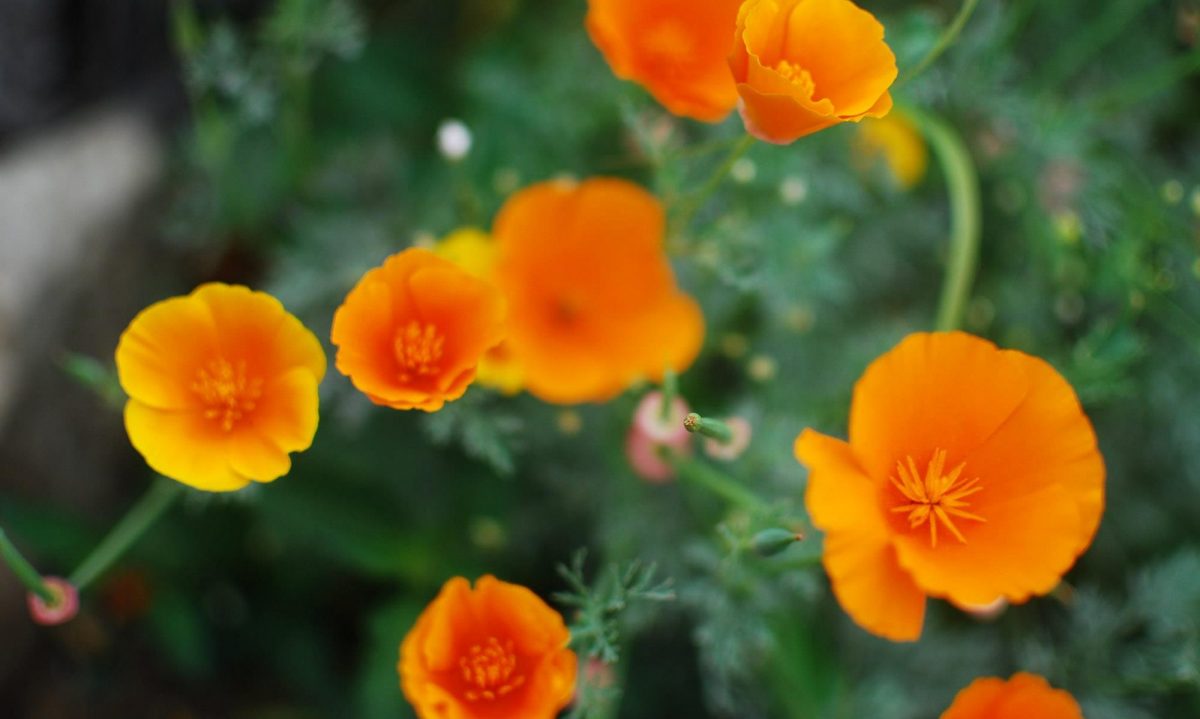










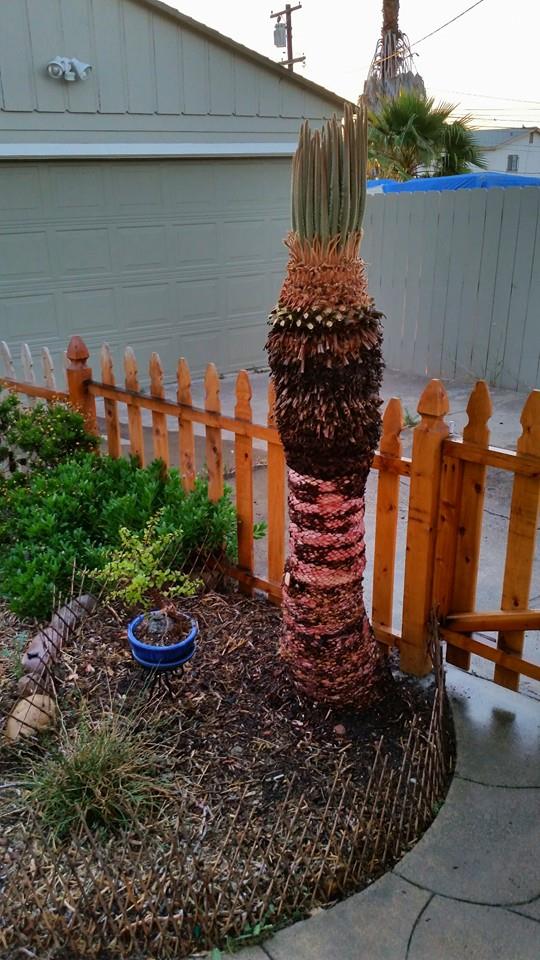

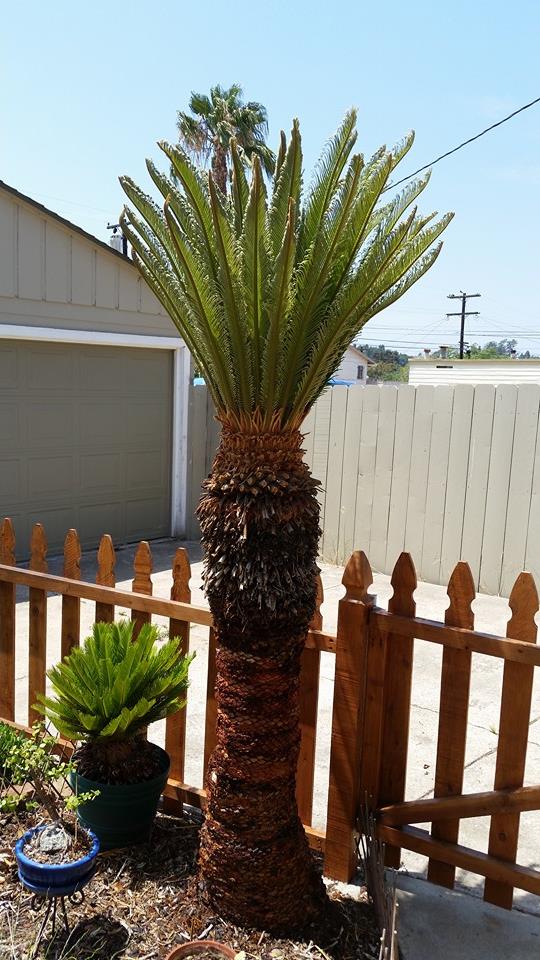
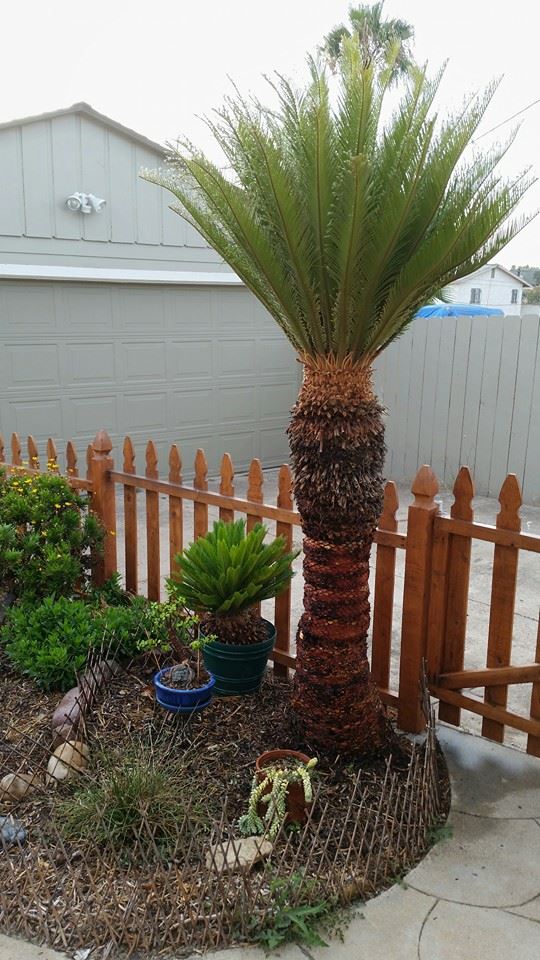
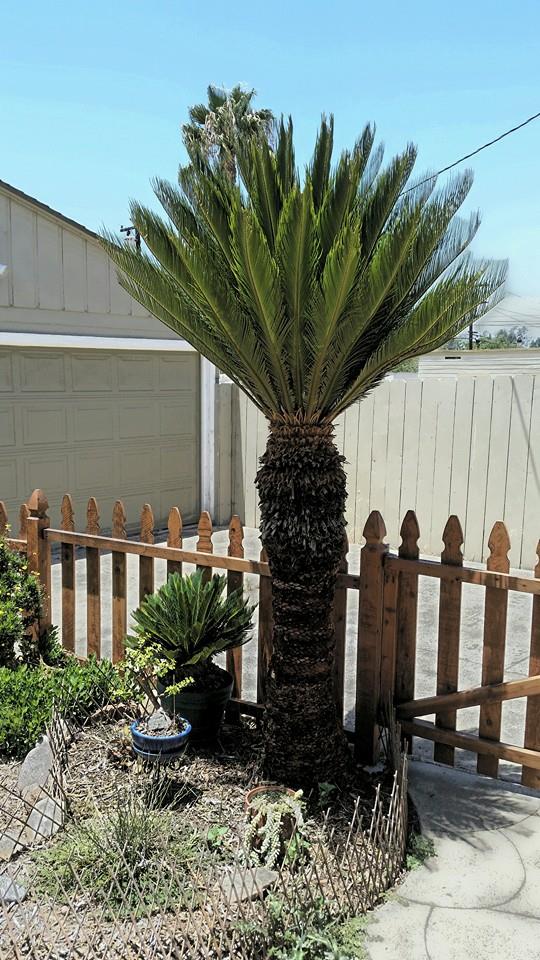
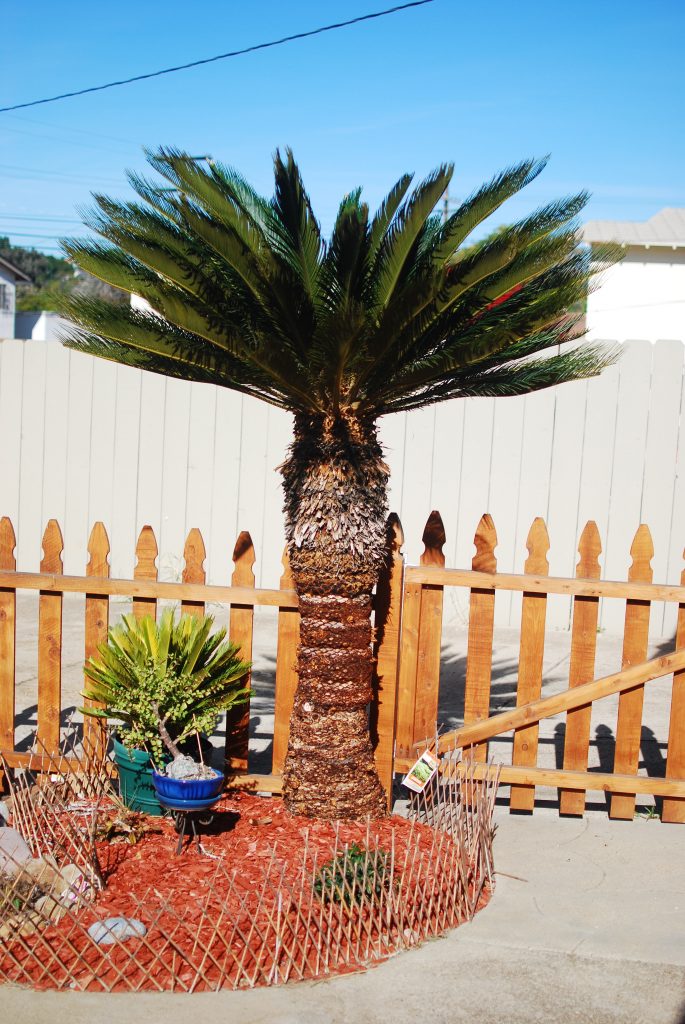

Well James that’s the best story I’ve read for a while, thank you! Such a fight you went through and with very good results. I had never heard of the Sago tree, not popular yet in this part of Europe, but I am forewarned. Great photos too.
Thank you Agnes! I’m glad you liked it! The battle isn’t quite over yet, the sago blooms every 2-3 years so I’ll be back at it again before too long. This way at least, I have a clean plate from which to work with. Thanks also for your continued comments! It helps to make me feel like I’m not wasting my time on this blogging project when I get actual feedback from actual people!
Warmest regards,
James
I was surprised at how good looking that tree ended up looking. Really beautiful! Can’t help but wonder about the process if you do decide to sell it… Also, the maintenance and taming of this girl sounds like an ongoing project. It is scary that they are so toxic and so readily available and popular. Geez
You and I both Cynthia! I thought for sure that I had gone too far and destroyed the poor girl.
As for selling it, it would have to be dug out with a back ho of some sort in order to preserve as much of the root ball as possible. Then wrapped in burlap and trucked off to its new home. I’ve done similar work in my youth as a landscaper and it’s not too complicated. You have to defoliate it aggressively to give it time to bounce back in its new location. Actual palms usually have their fronds bundled and tied together for the first year until the roots take hold. The King palm that is in my neighbors yard is worth well over 10k if they ever decide to sell it. And they have 3 of them! Usually new businesses buy them, like hotels or casinos. They want stately trees for the promenade or the like and have to get them somewhere. Private owners are usually cheaper than nurseries, so they will sometimes shop around that way.
As for the continued maintenance, I’ve done most of the major dirty work already. The sago only flowers every 2-3 years so I have bought myself some time. The trunk will continue to be smooth now and only the pups will need to be removed, which is very easy to do. When it gets taller than I can reach, then it will become an issue. It grows so slowly though, I may be dead before then or move elsewhere.
Thanks for your comment! What shocks me most is how little information nurseries will give you regarding this cycad. I just hope that people read this article and maybe I can save a few furry lives in the process!
Great, potentially life-saving PSA. I remember 10news airing a story ab
…my fat fingers hit “Post” before I was ready. I was saying that I remember seeing this in the news and found a clip; perhaps you could get fancy and embed it into your post. Truly scary how nurseries were/are giving customers misinformation: http://www.10news.com/news/pet-owners-sound-alarm-on-poisonous-plant-that-nearly-killed-dog-aspca-say-sago-palm-plant-parts-poisonous-to-pets-050213
I forgive your fat fingers. And thanks so much for the link!! I’ll definitely try to embed that. At least others are beginning to see how dangerous some plants are to pets. I’m REALLY shocked that City Farmers didn’t say anything. They usually have the heads in the game 100%. Maybe they talked to someone other than Bill.
Thanks for stopping by at my blog. Your Sago Palm post was very informative. We also have many on the Gulf Coast and they appear in my garden constantly. I usually pull them up, but I did let one grow. I was told to never inhale or disturb the blooms as it was bad for the lungs.
The same thank you goes to you! I’m glad you dug the sago palm post. I think this plant is best seen from a distance due to its toxic nature. It’ll also make you bleed just be looking at it. Even more so than any cactus I’ve grown.
Sheesh, I knew I didn’t like these plants for a reason. I’m usually not a fan of anything that wants to stab me. They are beautiful, though. They’re all over in the Pacific NW, too. Never knew they were so dangerous. I once did a safety presentation at work about common garden plants that are toxic … so many common ones are; it was quite surprising. Thanks for the info.
Yeah, we have a love/hate relationship. I keep one eye on this tree and one hand on my machete. Your move sago!
Great story fitting for a great tree!! I could almost see you screaming like Captain Ahab: “From hell’s heart I stab at thee!!!”
🙂
Indeed. For hate sake, I stab at thee. A machete is a powerful weapon, er… I mean tool.
Trying to find out if Sago palm leaves touch other palms will the other palm leaves brown and then die?
I wouldn’t thing so. Although, they’re so sharp the may shred the fronds if it’s windy. Apart from that, it’s most likely okay. Their toxins don’t effect other plants as far as I’m aware.
Well done lol … its a shame really such a beautiful plant is so dangerous .. .such is life i guess and i doubt it would have survived a cple 100 million years had it not been so …
So true Jay Dawg! I do have a lot of respect for the sago. And over a year after I wrote this and the tree is still on lock down. No incidents to report.
My husband and I just bought our first house about six months ago and there are two Sago Palms planted right next to the driveway. They must be fairly young as they only stand about 3.5 feet tall. Which means they scratch the heck out of my car every time I pull in and out of the driveway. I have been contemplating taking them out, and after reading this I think I have made up my mind. Thanks for the info!
They are very stiff and pointy bastards aren’t they? Something to bear in mind, if you can successfully remove them and place them in pots they are worth a pretty penny. Provided they survive the transplant. Let me know if you go that way and I’ll try to help you through it.
Oh, I almost forgot! Congratulations on your first house!! Very exciting isn’t it? There are tons of tips and articles here on Mind Your Dirt. I’m also very responsive to my commentors and followers so let me know if you need any help or advice.
i ran across your story when searching for info on pruning or moving a sago. We have one near the front door that is now so wide across it is blocking the sidewalk. OK for salesmen but I feel bad for the trick-or-treaters. My husband hates it and wants it gone but I am now deathly afraid of it. 🙁 Maybe i can find a landscaper to give it to if they will just come dig it up. Thanks for sharing your story~
It is quite the burden especially if it’s not in a location you want. Blood will be drawn.
As for giving it away, that should work just fine but I would explore selling it first. They are very slow growing so if you have a good sized specimen, then you can make top dollar for this species. Do a few searches for trees for sale that are similar to yours to get an idea of pricing. Large older palms can go for over 10k.
I’d just hate to see you and your man add insult to injury! Good luck and let me know if you need any advice or anything.
I have seen a dog chew and eat some of the sago seeds, the dog was a tiny little mut and it didn’t get sick at all… Maybe you should research before you tell people to chop up their plants… Humans don’t eat them, and i have never seen a dog mess with mine. I’ll keep living life unafraid, there is a better chance you’ll die in a car than you’re sago…
Gonna get this out of the way immediately. Your. Great, the pedantic in me can now move on.
This is a well researched toxin. I can’t account for your dog apart from saying it’s not a guaranteed death sentence, but a HIGH probability. There’s also people in the world that have been shot in the face and survived. That doesn’t infer that I’ll write an article saying it’s a good idea to shoot yourself in the face based on that result.
I also don’t say anything about people chopping up their plants. On the contrary actually and my sago is still thriving in my yard.
I do however have a barrier around it and remove the seeds every season as a safety protocol. What you allude to as fear, I call common sense and a liberation of stupidity.
I have a sneaking suspicion that you may not be here for civil discourse however. That you’re just looking to be slanderous and confrontational. Am I close to the mark?
Have fun pretending to be tougher than poisonous plants.
I was at the Home Depot recently and noticed that they were selling the same plants that are on one side of my front walk (they were already there when I bought my house a few years ago). Curious as to what they were, I looked at their labels and saw that they were Sago Palms. I also noticed that they had tags on them warning that they were highly toxic. Well, that was an unpleasant surprise.
I have a cat who is an indoor kitty so he’ll be ok but I didn’t like the idea of having a plant on my property that could be dangerous to neighborhood animals or maybe even a small child. I always thought they were strange looking plants to begin with, so they had to go. I found a landscaper who was willing to dig them up and take them away.
The only thing I am wondering about now are any roots that may still be left behind in the soil. Do the toxins break down over time or is that soil permanently tainted?
I’m confident that you have eradicated the danger sufficiently enough and don’t have to worry about soil contaminants at all. The biggest danger with the Sago “palm” (actually a cycad) is with the female and her seeds.
I deflower mine every year…
https://mindyourdirt.com/2015/09/01/deflowering-the-beast/
and it doesn’t take too much effort to remove all the seeds. Not including the amount of blood loss I receive during the process. Which brings me to my next point… the leaves and stems of this plant are so stiff and painful, that no animal would ever eat it for long, or enough to kill it, due to the pain.
Again, the seeds are much easier to eat and actually tasty (I’ve been told). Like antifreeze, a delightful poison best paired with a zinfandel. It is similar to a palm nut, which my dog loves to eat.
I still have my tree, but vigorously fenced off and viciously pruned annually. They are worth a great deal of money once fully matured and properly trained. I couldn’t bear simply removing it. I’m not surprised you found a landscaper to take it away, they most likely sold them for a pretty penny!
So, long story short, I wouldn’t worry at all about the soil or remaining roots. Thanks for commenting!
Cool, thanks for answering so quickly. I think I’m just going to spread some grass seed in that area and leave it be. Finding out that the prehistoric-looking plant in my front yard was toxic was a bit of a shock and I do have a tendency to overreact to things, but I’m still glad I removed them. No joke about the leaves being sharp – the only real contact I ever had with the plant was when I accidentally brushed by it an they poked me in the leg right through a pair of thick jeans. After that, I gave it wide berth.
” Like antifreeze, a delightful poison best paired with a zinfandel”
Hahaha. Yeah, years ago I had a lower radiator hose come loose while the car was in my garage and I ended up spending an entire day thoroughly cleaning up the mess so my cat wouldn’t get it on his paws. I think cats are a bit smarter about eating strange things, but they lick those paws (and everything else) clean all the time. Again, perhaps an overreaction but there have been times in my life when my tendency to do so has ended up heading off disaster.
Aloha!
One is glad to be of service! I may not always add new articles to Mind Your Dirt, but I ALWAYS reply to comments right away.
What makes the sago extra confusing is there is a species of an actual palm tree named sago that has edible parts to it. It’s called “sago palm”. Not to be confused with “sago palm”. Genius right?
Hi James
I was recently stabbed by one of these plants and started feeling unwell that day and by the next day it had blown up to a nasty sore. I went to the doctor and got antibiotics but ended up in hospital on an IV drip. I was wondering whether you have heard any thing like this happening to anyone else from being stabbed by this plant or maybe it just got infected as I live in tropical Darwin, Australia!
Thanks
Cherinne Lazarou
Wow! So sorry to hear this! If I were to wager a guess, I’d say that it was an infection and not poisoning from the Sago. I’ve personally been stabbed about fifty times with mine. Deep ones too. The worst one was a good inch into my hand. Apart from soreness and a whole slew of curse words making my dog’s head go sideways in confusion, no bad effects lingered.
You live in Darwin huh? I’ve always wanted to visit there! I believe Darwin has the world’s record for most lightning strikes per year. Somewhere in my closet I have an old giant map (like the ones they had in classrooms). In marker I circled Darwin and drew some lightning bolts and wrote, “must go here” back when I was in college. I love and miss the air after a lightning storm. San Diego never gets them.
Great read!
Did you do something to have the trunk look like that permanently or do you have to maintenance it each year?
Thanks AJ!
Every so often, a pup will appear on the trunk. A flathead screw driver makes light work of those. *pop* and off they come. You can let them dry out and replant them if you want.
So, essentially, the mono-trunk does remain. The last time I popped pups off was about three years ago. So it’s not often.
Entertaining story. We bought our house last year and today I got excited about dealing with the sago palm in our front yard. It’d been somewhat neglected since planted in 2000. After moving in last fall, I had a landscaper come trim all the plants and he merely chopped the fronds off all the pups that had spread around more than half the base of the plant. Loving the palm (and not having any pets, only a young grandchild who doesn’t eat most food let alone something in a yard), I felt it would be great to take a few pups to pot and give to friends and family. Not one to stop at 3, I chopped and hacked for a couple of hours resulting in 30+ pups which are now stored in the garage to harden off. Being one to read up AFTER beginning a project, I came across your article. Main question (sorry to have carried on so) – did you put any fungicide or treatment on the base of the plant after whacking the heck out of it? From what I read, others are saying they can get major infections after such a pruning. And, I was extremely aggressive trying to remove those pups from the base chopping and leaving the trunk and some pups with open wounds. Should you have an answer, please let me know your thoughts. Thanks!
Hi Patti, this story sounds very familiar to me. When I got my house, the sago was a wild beast. More of a bush than a tree. I pulled off pups that were much bigger than my head at the base. Leaving huge scars in the process.
When I learned how potentially dangerous it is to my beloved pooch, I didn’t really care if it got infected or didn’t bounce back. I just knew it needed to be tamed. So I did nothing in regards to a fungicide. Although it totally makes sense.
I’ve pulled pups every year for the last 5 years and the tree hasn’t suffered in the slightest. In fact, the opposite. It’s healthier now than it’s ever been. So, perhaps I’ve just been lucky. But I wouldn’t worry too much about yours. Maybe if you want to you can add a nice balanced fertilizer to help boost its immune system a little as a precaution? Otherwise, rest easy and avoid letting it stab you. Every year, this beast draws blood.
Maybe it’s my blood that makes it so resilient…
Hi,
Came across your blog while searching for why the new fronds on my cycad had browned and shriveled up. It was fun reading. Over the years, have had my share of nicks and cuts and stabbings but now, hopefully, it will help itself!
Hi Anita. Were you able to find what happened to your cycad? You mean the new fronds that come out of the top center of the crown? I haven’t seen that before and would be interested in your findings!
Thanks for stopping by and dropping me a comment! Cheers.
Good day James, I went to the doctor today and there were about 10 or more of these plants in the various spaces bordered by sidewalks. In the main garden was a Sago that was about 8 feet tall and the trunk looked nearly 2 1/2 to 3 feet in diameter. It had two layers of fronds below the main part at the top. Above each frond layer was a belt full of seeds. It was a very impressive looking plant, so much so, that I collected several of the seeds in hopes of growing my own behemoth for my front yard.
While conducting some research on growing Sagos from seed I came across your article. I really appreciate the information as I had no idea how dangerous they are. I read about six articles on propagating Sagos from seeds and none but one mentioned the toxicity of the plant. Fortunately your article was a related link on the last one I read.
After reading your blog I did a bit more research and likely will try to grow them from seed. I, however, will not be adding them to my landscape. I live in a small rural community and there are lots of my neighbors beloved pets running around ot here. I would feel terrible if one of them were to become ill or die as result of something I added to my garden. I will look for something else to put out.
Your article also made me think about other plants that I add to my landscape. As a member of this community, I have a responsibility to be as safe as possible when planting. I need to conduct a bit more research. I need to know more than the amount of water, sunlight, and fertilizer to use. I need to know if they’re dangerous to people or pets. I honestly never considered that when adding plants to my yard. Thanks for enlightening me to this potential pet hazard and for adding a new layer to my garden planning.
Steve
Good evening Steven. I hope it doesn’t put you off of some lovely (yet toxic) plants. My sago is still going strong here and I’ve taken steps to make sure my precious dog doesn’t eat any seeds.
Like a very dense ring of bushes around the base to make foot traffic impossible for dogs. And annual pruning (albeit heavy-handed) to keep things tidy.
There’s a large garden (I wanna say in England) that only houses the most toxic plants that can grow there. Lots of signage and fencing keeps people from touching them. I’m sure you can easily Google it and you may find it fascinating.
So I won’t dissuade you from following your original interest with the sago. And they grow so slowly, it would be years before it would be as large as the one at the doctors office. In fact, that’s what makes them so expensive. Large specimens take a great deal of time.
With that in mind, I’d recommend that you propagate from a pup and not a seed. Don’t quote me on this, but I’d be surprised if the seed was viable anyways. The sago needs a male to reproduce by seed I believe. So many seeds would logically be infertile if the female is alone in a landscaping environment.
With pups, you can pull a rather large one and save yourself years of growth. They are so easy to pry off with a large screwdriver or prybar. Then you let them dry out for a couple weeks somewhere dark and dry. Like a garage. This keeps them from rotting when you pot them. I’m sure there are many articles that go more in depth, but that would be my recommendation.
All that being said, I think it’s fantastic that you’ve added a new layer to your landscaping designs. Responsible gardening is the true noble work. Humans can do such damage to an ecosystem (even with good intentions). Like planting non-native tropical milkweed for the monarchs. Which does more harm than good by messing with their migratory patterns. Yet Home Depot sells tropical milkweed and labels it “butterfly attractor”. Aaand also sells RoundUp in the next aisle. But I digress.
I’m so glad you visited and even happier that you commented. Thank you kindly and don’t be a stranger!
Hi James. I did leave it alone and about a week later discovered a beautiful new set coming out of the crown. A bit worried, this time I gave it a spray of malathion and it is flourishing now. Thereafter, I came across an article saying a blue butterfly/caterpillar is responsible for the yellowing/ withering fronds and there were plenty around here at that time.
Well that’s good news. I’ll have to look for that article as I’m curious what species of butterfly that is. Glad to hear about the bounce-back. Thanks for the update Anita!
It is Pandemic 2020 and the last post here was 2014. I just hacked at my very over grown Sago Palm and have been trying to figure out how to get rid of the large population of ‘pups’ at the base and on the trunks; your post is very helpful. My Sago lives in central FL and is ~22 years old and, happily, is male. Since this is our winter home, I’ve done a good job of ignoring it and letting the landscape people do nothing to it. Finally bored with sourdough bread making we headed outdoors to trim & prune. We will let it rest for a bit and then have a go at those pups after a trip to Home Depot for some tools. Thanks for the information!.
Hi Susan! Thanks for dropping a line. My sago is still doing perfectly well all these years later. Getting nice and tall and stately.
I use a large standard screwdriver as a prybar to pop those pups right off. Takes no effort if you get it at its base and just pry off.
Also, I’m working on my sourdough skills! Got my #3 loaf cold proofing as I write. Thanks again for visiting my lil gardening blog!!
We have an 8 foot sago in our yard here in Louisiana. It had to have been already large when planted (our house is 20 years old, however we’re 2nd owners for about 2 years now). I remember when we bought it I wanted to re landscape, and I took out the hydrangeas around it (they don’t do well here) and just looked at the mess the palm was. There were dead fronds all down the trunk, and I just took my pruners and dived in. 3 hours and one doctor visit later it looked gorgeous. We had 3 more that were in poorly thought out places and removed them sadly. However someone came and picked them all up from the side of the road. And a fun fact, as they are a relative of the fern, they can root in the ground if you accidentally cut them above the roots. Just plant the trunk and make sure it doesn’t rot.
We dug up a sago palm having no clue about it or its dangers. Our 8 month old puppy started eating pieces that were falling off of it. She got sick that night and died 3 days later at the animal emergency hospital despite 3.5k in life saving efforts. This plant is no joke.